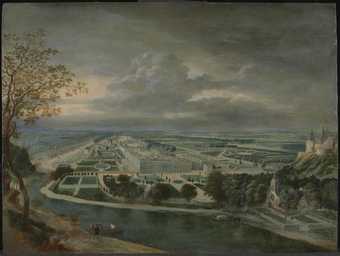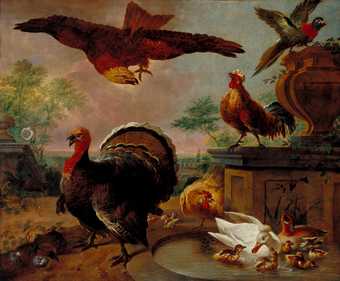Artist biography
The Dutch painter Jan Griffier was born in Amsterdam. Walpole says he was first apprenticed to a carpenter, a tile painter and a flower painter before becoming a pupil of the etcher and landscape painter Roelant Roghman (c.1620-86). According to Walpole he also studied informally with Adriaen van de Velde (1636-72), Jacob van Ruisdael (1628/9-82) and (doubtfully) Rembrandt.
Griffier moved to London soon after the Great Fire of 1666, which he depicted in several paintings. In London he continued his studies under Jan Looten (1618-81), painting numerous highly finished, small London and Rhineland views 'which he executed with richness and neat colouring, and enlivened with small figures, cattle and buildings' (Walpole 1888, II, p.130). He was admitted a 'free-brother' of the Company of Painter-Stainers in London in 1677, contributing a Landscape with Ruins to their hall. An expert etcher, Griffier produced a series of plates of birds after Francis Barlow, as well as a number of mezzotint portraits after Peter Lely and Godfrey Kneller. Walpole states that Griffier had his own yacht on the Thames, from which he sketched scenery, and he seems to have travelled widely between the main British cities, including London, Windsor, Oxford and Gloucester, of which he painted views.
He returned to Holland around 1695, apparently in his yacht, which was shipwrecked off the Dutch coast; he remained in that country for about ten years before returning to London, where he bought a house at Millbank. He enjoyed the patronage of the Duke of Beaufort. Walpole notes that 'mixed scenes of rivers and rich country were his favourite subjects' (Walpole 1888, II, p.131); his prospects of Hampton Court Palace (c.1710, Tate Gallery T00408) and Syon House (c.1710, collection Duke of Northumberland, Syon House) combine real views of the houses with fantastic landscapes. In his later years he widened his subject-matter to include imaginary landscapes with fantastic figures, such as A Turkey and other Fowl in a Park (1710, Tate Gallery T04129), as well as marine views. Vertue called him 'in his latter part of his time a great mimick of other masters both Italian & flemish. in which succeeded & deceived very well. livd somewhat retird towards his latter end & died (at his house on millbank Westminster) of a good old age (72)' (Vertue I, p.51). His son Robert Griffier (1688-c.1750) and grandson Jan Griffier II (fl.1738-73) were also landscape painters. After his death an auction of his pictures took place at Covent Garden, London.
Further reading:
Horace Walpole, Anecdotes of Painting in England, revised edition, London 1888, II, pp.129-31
'Vertue Note Books I', The
Walpole Society, XVIII, Oxford 1930, pp.50-1
Ellis K. Waterhouse, A Dictionary of 18th Century British Painters, Woodbridge, Suffolk 1981, II, p.150
Lindsay Stainton and Christopher White, Drawing in England from Hilliard to
Hogarth, London 1987, p.181
Jane Turner (ed.), The Dictionary of Art, London 1996, XIII, p.647
Terry Riggs
February 1998
Wikipedia entry
Jan Griffier (c. 1652 – 1718) was a Dutch Golden Age painter who was active in England, where he was admitted to the London Company of Painter-Stainers in 1677.
This biography is from Wikipedia under an Attribution-ShareAlike Creative Commons License. Spotted a problem? Let us know.
Read full Wikipedia entry


